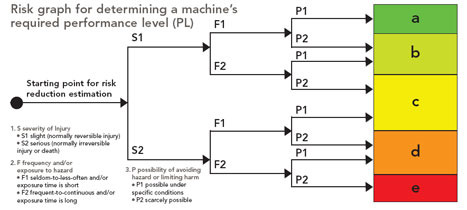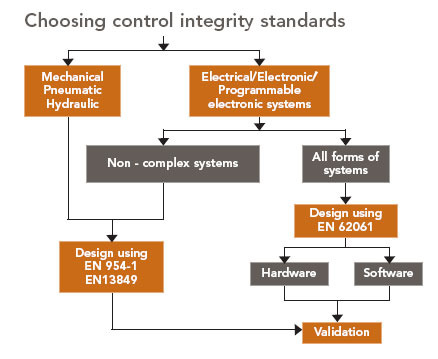EU's machinery safety changes pose a threat
1 Apr 2011
Machine builders, OEMs and even end users could face losing business and be hit by penalty fines if they do not get up to speed with on-going changes to the EU’s machinery safety requirements.
While the Machinery Directive has been in force for about a year now, there have since been many significant changes for the industry to take on board, said Paul Laidler, managing director of UK machinery safety and compliance consultant, Laidler Associates.
“Nothing is in tablets of stone at the moment. Everything is evolving,” said one expert, summarising the current regulatory scene at a Laidler Associates/TUV Sud-organised press conference in London.
There is, therefore, much confusion among both manufacturers and end users of industrial equipment, who could face many legal pitfalls and costly penalties as a result of the changes.
Extra types of equipment have been added to the directive, with devices such as lifting accessories, removable mechanical transmission devices and partly completed equipment such as skid-mounted kit now having to be CE marked.
“But people are asking, ’where do I stop with this?’” said Laidler. “Is a door stop or a machine cover strut a safety device? Do they have to be CE-marked?”
There have also been changes to existing environmental, health & safety requirements (EHSRs), such as those covering how guards and protection devices are held in place. This could, for example, force many machinery builders to redesign the guard systems on their equipment.
Also not being fully taken on board are changes concerning the declaration of conformity (DoC) documents, which can no longer be simply signed off by the managing director, as previously.
A DoC now has to be cleared by the person holding the technical file. This is intended to ensure a path back to someone based in the EU, and so address industry complaints about non-compliant imports.
Likewise, Laidler believes that industry has not picked up on the ’life-cycle’ emphasis in the Machinery Directive: it now encompasses every product phase; through transport, assembly operation and maintenance up to dismantling and scrapping.
As well as having to tell customers how to scrap the equipment, the machinery maker now has to “get his crystal ball out and ask how someone might misuse [equipment throughout its life cycle],” said Laidler.
Confusion
But, perhaps, the main area of confusion is over what exactly is now covered by the part of the directive that requires that any failure within a control system - hardware or software - must not lead to a hazardous situation.
After a series of reprieves, the existing EN954-1 will be replaced at the end of the year. While it was easy to use and flexible, the standard predates the introduction of software and electronic logic, which are now standard in safety control applications.
One of its two replacements, EN62061is a purely electrical standard, which, said Laidler, is adaptable and cost effective for complex machinery used in specialised areas and/or requiring specific SIL levels. However, another standard, ISO13849, will be the main, direct replacement for EN954-1.
While EN954 was “like an MOT”, ISO13849 is very different, said Laidler. For example, he said, it uses a mean time to (dangerous) failure data (MTTFD) metric to determine how many hours of operation a piece of equipment can work safely.
ISO13849 introduces performance levels (a,b,c,d,e) for safety-related parts of the control system, based on the probability of a dangerous failure per hour (see diagram p13). Central to this will be the MTTFd, which is based on information from manufacturer.
The standard requires a four-stage approach:
- Perform a risk assessment;
- Allocate the safety measure (Performance Level (PL)) for the identified risks;
- Devise a system architecture that is suitable for the performance level;
- Validate the design to check that it meets the requirements of the initial risk assessment.
“This adds a completely new dimension to the ways people are going to have to work.” said Laidler. A big problem for industry, he forecast, will be a lack of available MTTFd data, as well as the required expertise that many companies, especially smaller companies, will not have.
There is particular confusion around PL and categories that are achievable by assessment and through validation, added Laidler, citing a manufacturer that carried out 13849-1 assessment and installed a safety circuit. A Laidler validation, however, found that it could not achieve the required PL, so that the company had to remove newly installed circuitry and start again - at significant cost.
’Can’t buy off you’
Overall, Laidler said that these changes will take a while to filter through, but cautioned: “The fear is that, come 2012, your biggest customers say ’I can’t buy off you any more, as you’ve not gone to ISO13849’.”
The conference went on to highlight end user responsibilities under the Provision and Use of Work Equipment Regulations (PUWER). These require employers to ensure that the equipment they buy or modify is safe to use and will be operated in accordance with the manufacturer’s instructions.
Employers must also check that any new equipment - or existing machinery if/when modified - meets the requirements of the relevant directive, has a CE marking, suitable instructions and a DoC.
If a company introduces a piece of kit it must ensure that it meets all the new HSERs, and it must carry out all the inspections, according to Laidler. “Once it’s on your shopfloor, you are fighting a losing battle. The only defence is due diligence, doing everything you can to comply with requirements,” he said.
These issues affect not only company directors, but also individuals with responsibilities for HSE, concluded Laidler, noting that CE audits at end user companies was currently a major growth area for machine safety consultants.





